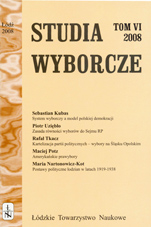System wyborczy a model polskiej demokracji
Electoral system and the Polish model of democracy
Author(s): Sebastian KubasSubject(s): Politics / Political Sciences
Published by: Łódzkie Towarzystwo Naukowe
Summary/Abstract: The study comprises of four main parts. The first part focuses on an introduction to a very complex subject of changes in election law and motives that lie behind them. Stress is laid upon the fact that electoral law manipulation is a successful method of influencing outcome of an election. Therefore it is a temptation that political parties cannot resist otherwise they’re eliminated and survived by the fitter. Other notable factors affecting changes in election law are the intricate mathematical nature of elections and usually limited knowledge of participants in election process. The second part deals with fundamental flaws of single member plurality system (SMP). Majoritarian and proportional visions of elections as instruments of democracy are incompatible. Therefore, an attempt is made to expose disqualifying flaws of the SMP system on the sole basis of majoritarian vision. Above all, this system all too often produces wrong winners because it does not satisfy the first Condorcet criterion. Moreover, in reality it’s rather a dominating minority system in which voter minorities are permanently transformed into government majorities. In the third part of the study possible changes to Polish election law are discussed. The purpose of this deliberation is determining the extent of alterations of the Polish Election Statute allowed by the Constitution. Past experiences suggest that these alterations usually are a concealed maneuver conducted immediately prior to election. Thus, the Constitutional Tribunal should strictly assess the period after the expiration of which the new regulations come into force (vacatio legis). A suggestion is made that the Constitutional Tribunal should declare unconstitutional regulations fundamentally changing the election law that take effect before the subsequent election. Next, a reasoning is presented which leads to the conclusion that the introduction of a mixed electoral system for elections to the Sejm (the first chamber of Polish Parliament) is excluded by the Constitution. This question is elaborated in the fourth, last part of the study. Another issue discussed in the third part is the choice of a proportional electoral formula. Some simulations of the composition of the Sejm are presented using the d’Hondt method and two variations of the Sainte-Laguë method. Making use of power indices justifies the thesis that the Polish Constitution does not exclude any particular proportional formula. Attention is also drawn to the district magnitude as this is a component of an electoral system which is particularly prone to manipulation. Another set of simulations shows that the district magnitude lower than four leads to pseudo-proportional results. In the final, fourth part an overview is given of the crucial role that the proportional election to the Sejm plays in the Polish model of democracy.
Journal: Studia Wyborcze
- Issue Year: 2008
- Issue No: 06
- Page Range: 7-46
- Page Count: 40
- Language: Polish

